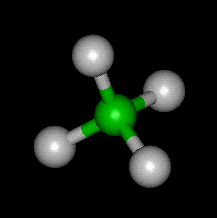|
The Methane Molecule |
The simplest hydrocarbon , methane is a gas with a chemical formula of CH4.
 |
Methane |
The carbon atom central to the methane molecule has 4 valence electrons and thus needs 4 more electrons from four hydrogen atoms to complete its octet. The hydrogen atoms have a 109 degree bond angle giving the molecule a tetrahedral geometry .
A principal component of natural gas, methane is significant . Burning one molecule of methane in the presence of oxygen releases one molecule of CO2[carbon dioxide) and two molecules of H2O (water):
- CH4 + 2O2 ---> CO2 + 2H2O
The strength of the carbon hydrogen covalent bond in the methane molecule is among the strongest in all hydrocarbons, and thus its use as a chemical feedstock is limited. The search for which one can facilitate C-H bond activation in methane and other low alkanes is an area of research with considerable industrial significance.
Pure methane is odorless, but when used as a fuel it is usually mixed with small quantities of strongly-smelling sulfur compounds such as ethyl mercaptan to enable the detection of leaks.
Methane is a greenhouse gas with a global warming potential of 22 (meaning that it has 22 times the warming ability of carbon dioxide).
Methane results from the decomposition of certain organic matters in the absence of oxygen. It is therefore also classified as a biogas.
The U.S. Geological Survey has estimated that the United States has 320,000 trillion cubic feet of gas hydrates, some 200 times conventional natural gas resources and reserves in the country. If only 1 percent of the methane hydrate resource could be made recoverable, the United States could more than double its domestic natural gas resource base
Principal sources are
- decomposition of organic wastes ;
- natural sources (;marshes) : 23 %
- fossil fuel extraction : 20 % Coal bed methane extraction
- the processes of digestion of animals (cattle) : 17 %
- bacteria found in rice plantations : 12 %
- biomass anaerobic heating or combustion
80% of the world emissions are of human source. They come primarily from agricultural and other human activities. During the past 200 years, the concentration of this gas in the atmosphere doubled, passing from 0.8 to 1.7 ppm.
See also:
What is the geometry of the methane molecule? An interactive activity which includes a jmol applet of methane.
Some or all of this text has been obtained from Wikipedia, the free encyclopedia. All text is available under the terms of the GNU Free Documentation License (see Copyrights for details). Disclaimers. Wikipedia is powered by MediaWiki, an open source wiki engine.

